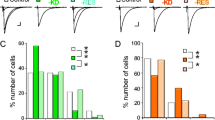Abstract
Elimination of early-formed redundant synapses during postnatal development is essential for functional neural circuit formation. Purkinje cells (PCs) in the neonatal cerebellum are innervated by multiple climbing fibers (CFs). During postnatal development, a single CF is selectively strengthened in each PC and becomes a “winner” CF that is presumed to remain into adulthood, whereas the other “loser” CFs are eliminated. These developmental changes are dependent on neural activity and signal cascades in postsynaptic PCs. Several molecules essential for CF synapse elimination have been identified in postsynaptic PCs. Importantly, we have recently uncovered that Semaphorin3A (Sema3A) and Semaphorin7A (Sema7A) derived from postsynaptic PCs act retrogradely onto presynaptic CFs and regulate CF synapse elimination. We demonstrate that Sema3A strengthens and maintains CF synapses from postnatal day 8 (P8) to P18 and opposes the force of CF elimination. In contrast, Sema7A facilitates elimination of weaker CFs from PC somata after P15. In the continuing studies, we searched for molecules that mediate these retrograde semaphorin signals in presynaptic CFs. This short article describes how Sema3A strengthens and maintains, whereas Sema7A promotes elimination of CF synapses through respective receptors and downstream molecules in presynaptic CFs during postnatal cerebellar development.





Similar content being viewed by others
References
Watanabe M, Kano M. Climbing fiber synapse elimination in cerebellar Purkinje cells. Eur J Neurosci. 2011;34(10):1697–710.
Hashimoto K, Ichikawa R, Kitamura K, Watanabe M, Kano M. Translocation of a “winner” climbing fiber to the Purkinje cell dendrite and subsequent elimination of “losers” from the soma in developing cerebellum. Neuron. 2009;63(1):106–18.
Bosman LW, Konnerth A. Activity-dependent plasticity of developing climbing fiber-Purkinje cell synapses. Neuroscience. 2009;162(3):612–23.
Hashimoto K, Kano M. Postnatal development and synapse elimination of climbing fiber to Purkinje cell projection in the cerebellum. Neurosci Res. 2005;53(3):221–8.
Hashimoto K, et al. Postsynaptic P/Q-type Ca2+ channel in Purkinje cell mediates synaptic competition and elimination in developing cerebellum. Proc Natl Acad Sci U S A. 2011;108(24):9987–92.
Miyazaki T, Hashimoto K, Shin HS, Kano M, Watanabe M. P/Q-type Ca2+ channel α1A regulates synaptic competition on developing cerebellar Purkinje cells. J Neurosci. 2004;24(7):1734–43.
Ichise T, et al. mGluR1 in cerebellar Purkinje cells essential for long-term depression, synapse elimination, and motor coordination. Science. 2000;288(5472):1832–5.
Kano M, et al. Persistent multiple climbing fiber innervation of cerebellar Purkinje cells in mice lacking mGluR1. Neuron. 1997;18(1):71–9.
Levenes C, Daniel H, Jaillard D, Conquet F, Crepel F. Incomplete regression of multiple climbing fibre innervation of cerebellar Purkinje cells in mGluR1 mutant mice. Neuroreport. 1997;8(2):571–4.
Uesaka N, et al. Retrograde semaphorin signaling regulates synapse elimination in the developing mouse brain. Science. 2014;344(6187):1020–3.
Hashimoto K, Kano M. Synapse elimination in the developing cerebellum. Cellular and molecular life sciences. 2013;70(24):4667–80.
Pasterkamp RJ. Getting neural circuits into shape with semaphorins. Nature reviews. Neuroscience. 2012;13(9):605–18.
Scott GA, McClelland LA, Fricke AF, Fender A. Plexin C1, a receptor for semaphorin 7a, inactivates cofilin and is a potential tumor suppressor for melanoma progression. The Journal of investigative dermatology. 2009;129(4):954–63.
Vachon PH. Integrin signaling, cell survival, and anoikis: distinctions, differences, and differentiation. J Signal Transduct. 2011;2011:738137.
Watanabe F, et al. Effects of FAK ablation on cerebellar foliation, Bergmann glia positioning and climbing fiber territory on Purkinje cells. Eur J Neurosci. 2008;27(4):836–54.
Acknowledgements
We thank K. Matsuyama, M. Sekiguchi, and M. Baba for the technical assistance. This work was supported by Grants-in-Aid for Scientific Research (15H05568 to N.U., 25000015 to M.K.) from JSPS, Japan, and by Brain/MINDS from MEXT and AMED, Japan and SRPBS from AMED, Japan.
Author information
Authors and Affiliations
Corresponding author
Ethics declarations
Conflict of Interest
The authors declare that there are no conflicts of interest in the submission of this manuscript to The Cerebellum.
Rights and permissions
About this article
Cite this article
Uesaka, N., Kano, M. Presynaptic Mechanisms Mediating Retrograde Semaphorin Signals for Climbing Fiber Synapse Elimination During Postnatal Cerebellar Development. Cerebellum 17, 17–22 (2018). https://doi.org/10.1007/s12311-017-0888-z
Published:
Issue Date:
DOI: https://doi.org/10.1007/s12311-017-0888-z




